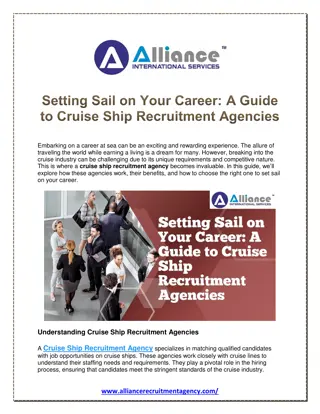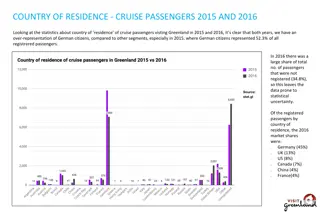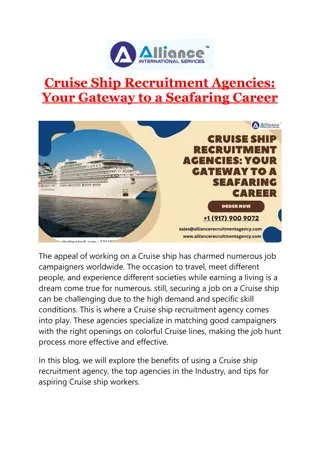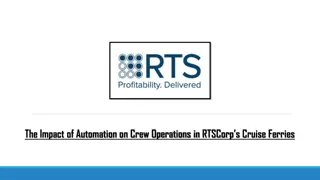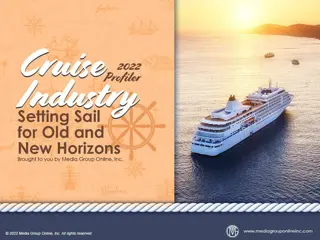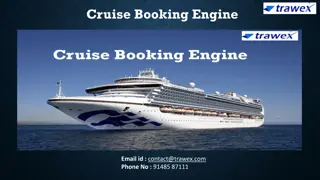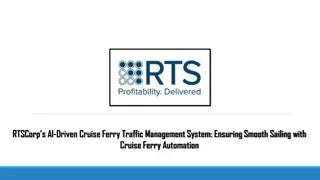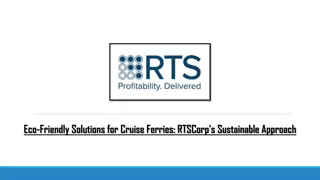Stranded by the Pandemic: Impact on the Cruise Industry
The pandemic significantly affected the cruise industry, leading to cancellations and financial losses for major cruise lines. Despite challenges, there is a desire to travel, including taking cruises, among consumers. Insights from surveys highlight varying perspectives and intentions regarding future cruise travel.
Download Presentation

Please find below an Image/Link to download the presentation.
The content on the website is provided AS IS for your information and personal use only. It may not be sold, licensed, or shared on other websites without obtaining consent from the author.If you encounter any issues during the download, it is possible that the publisher has removed the file from their server.
You are allowed to download the files provided on this website for personal or commercial use, subject to the condition that they are used lawfully. All files are the property of their respective owners.
The content on the website is provided AS IS for your information and personal use only. It may not be sold, licensed, or shared on other websites without obtaining consent from the author.
E N D
Presentation Transcript
Stranded by the Pandemic The pandemic has had a major negative impact on the cruise industry, as it has for all other leisure and hospitality sectors. The early horror stories of ships filled with passengers and crew prohibited from docking were well-documented. The Centers for Disease Control (CDC) initiated a No Sail Order March 14th, which was then extended through September 30th and extended again through October 31st; however, cruise departures could be delayed until 2021. The order extension to the end of October resulted in Carnival Cruise Line cancelling six November cruises from Florida and Royal Caribbean Group and Norwegian Cruise Line Holdings cancelling all November departures.
Looking for New Horizons As with hotels and airlines, cruise lines have suffered major financial setbacks. Carnival Cruise Lines reported a $1.7 billion Q3 2020 loss; nonetheless, the company expects some US cruises before the end of 2020; however, occupancy will be only 50%. Royal Caribbean reported during October 2020 it has experienced improvements in its 2021 bookings, but they are still less than the pre-pandemic period. Furloughs have impacted approximately 23% of US employees and new vessel orders are being delayed. Holland America Lines is planning the operation of five ships in Europe during the April November 2021 travel season. Norwegian Cruise Line still expects some 2020 cruises to occur, but these and others are more likely to sail during 2021.
People Long to Travel As with many leisure activities, there is a constrained desire to travel, and to take a cruise. According to August 2020 research from Cruise Lines International Association (CLIA), 75% of surveyed consumers who have cruised during the past said they want to cruise. Despite wanting to take a cruise, 47% of those responding to a late-September 2020 MMGY Travel Intelligence survey said they had cancelled an ocean cruise they had planned pre-pandemic, and another 38% said they had cancelled a river cruise. Considering a large percentage of people who take cruises are older and the news stories of being stranded on ships when the pandemic started, it s surprising respondents to the CLIA survey listed a vaccine last on a list of protocols they expect before taking a cruise.
Cruise Travelers Insights In a much larger sample than the CLIA and MMGY Travel Intelligence surveys, The Media Audit s 2020 Aggregate Survey (60 US markets and representing more than 158 million adults) found 6.1% of all adults said they plan to take an ocean cruise during the next year. The Media Audit survey revealed two primary cruise audiences: adults 25 49 (42.3%) and 50+ (47.3%); however, those 65+ over-index the most at 133 while the younger group has an index of 97. Interestingly, 14.7% of African Americans and 18.8% of Latinx Americans were planning to take a cruise during the next year and they skew much younger than all adults, or 59.5% of African Americans and 51.0% of Latinx Americans 25 49.
Cruising with the Kids According to the same 2020 Aggregate Survey from The Media Audit, the sweet spot for the family-cruise audience is, unsurprisingly, adults 25 49, or 61.7% with children at home of any age and planning an ocean cruise during the next year. Separating the data further reveals 79.6% of those adults 25 49 planning an ocean cruise have children at home 6 to 12 years of age, compared to 66.9% of those with children at home 13 to 17 years of age. Another important cruise audience is Latinx American families, as 23.2% of parents with children at home of any age plan an ocean cruise during the next year, 53.8% earn a household income of $50K $150K and 56.4% have a college or advanced degree.
Another Cruise Audience Not To Be Overlooked LGBTQ individuals and couples love to travel and even a larger percentage (7.3%) plan to take an ocean cruise during the next year than all adults 18+ (6.1%), all adults 25 49 (5.9%) and all adults 50+ (6.7%). A larger percentage of men (55%) in the LGBTQ community plan an ocean cruise. In most other non- LGBTQ demographic categories, the male/female split is almost even. Plus, those in the LGBTQ community planning an ocean cruise skew younger, or 56.6% 25 44. Comparing household incomes reveals a more even spread among LGBTQ adults, with 29.1% planning to take an ocean cruise with incomes less than $35K, 27.3% earn $35K $75K, 24.5% $75K $100K and 19.1% $150K+.
Advertising Strategies With the growth in family-cruise packages from Disney, specifically, and many other cruise lines, marketing to this audience is critical to establish an interest early in life for cruising among children and for young parents as they age. TV is still the best ad medium to reach the older cruise audience, so winter 2020 2021 is an excellent period to promote 2021 (and beyond) cruises as almost all reports indicate a pent-up market ready to enjoy cruising again. Local river cruises may be able to start before ocean cruises, promoting a limited number of passengers and maybe shorter trips than during the past. Ad messages can promote river cruises as a safe alternative and still an enjoyable trip on the water.
New Media Strategies Some cruise lines and even travel agents may want to adapt the online virtual tours many travel companies are offering to remain engaged with their customers and target audiences and to promote various trips and destinations for when it is safe. No doubt, major cruise lines are providing regular updates on their Websites and social media platforms about when ships can sail again and the health and safety protocols in place; however, local travel agents can also share such information, and with a local angle. With an increasing number of African American and Latinx American young adults planning a cruise during 2021, cruise-industry companies will want social media content appropriate for those audience, emphasizing fun and the cruise lines stance on environmental issues.





